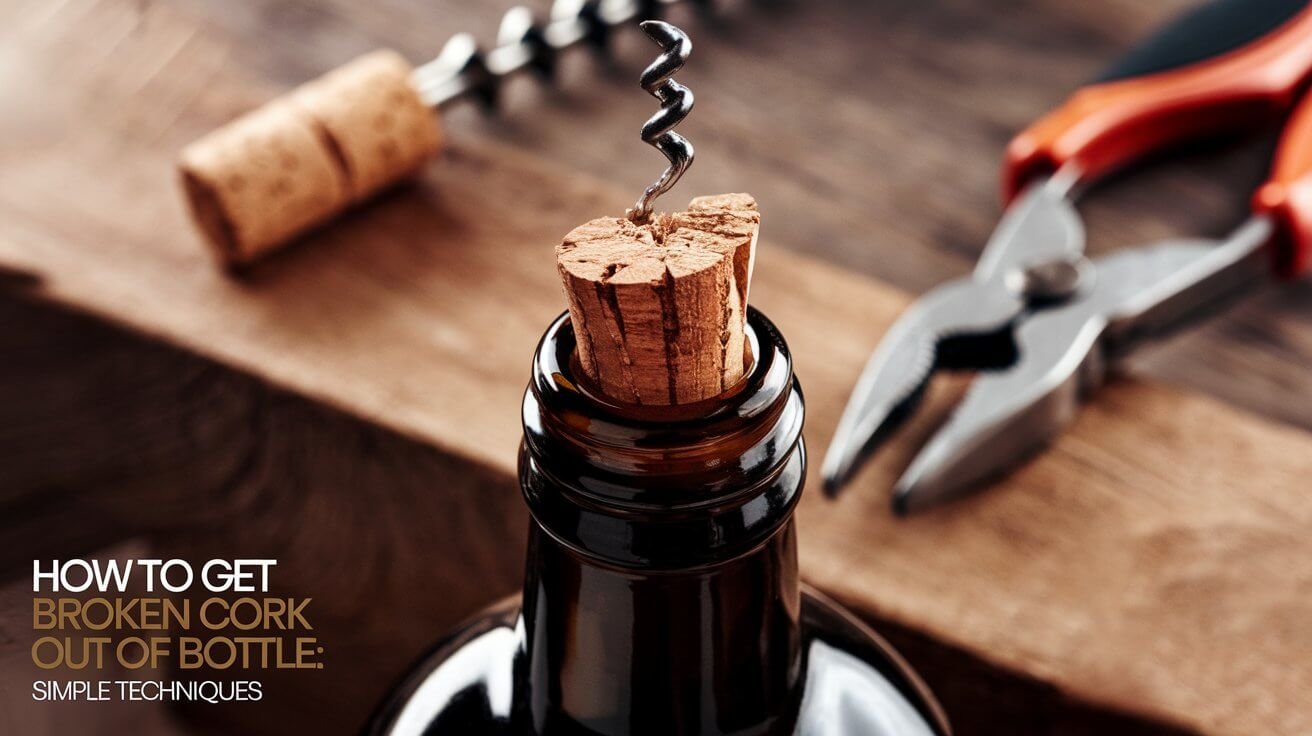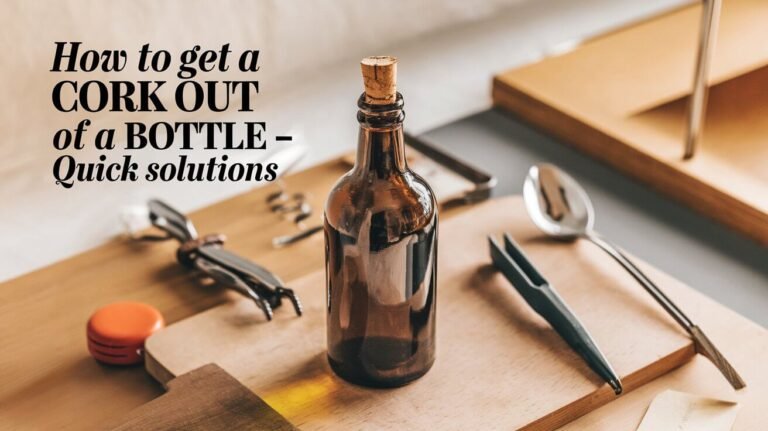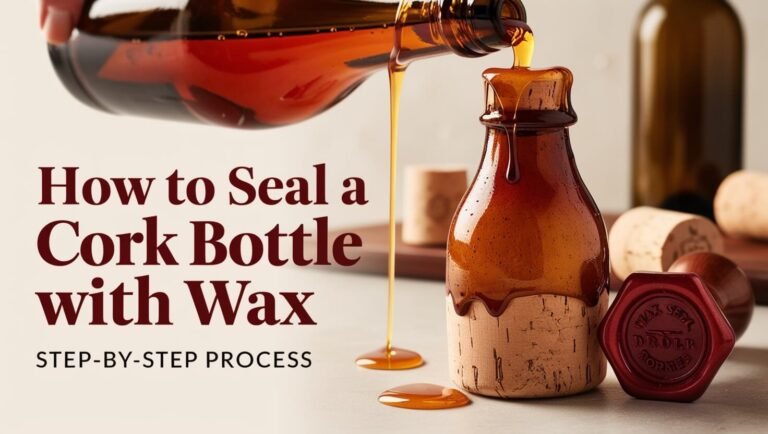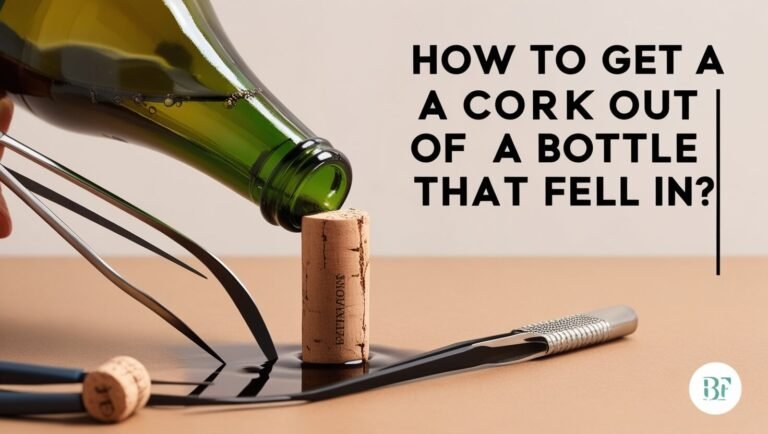How to Get Broken Cork Out of Bottle: Simple Techniques

Ever had a broken cork that just won’t come out of your wine bottle? Don’t worry, there are simple ways to get it out and enjoy your wine. Knowing why corks break and having the right tools is key.
Understanding Common Cork Problems in Wine Bottles
Enjoying a fine vintage can be ruined by cork issues. Problems like crumbling, splitting, and partial extraction can happen. They might be caused by bad storage, aging, or using the corkscrew wrong. Knowing about cork breakage and how to fix it is key to saving the wine.
Types of Cork Breakage
- Crumbling: The cork turns into small pieces, making it hard to get out.
- Splitting: The cork breaks into big pieces, often because it’s dry or you used too much force.
- Partial Extraction: Only part of the cork comes out, leaving some stuck in the bottle.
Why Corks Break During Opening
Corks break for many reasons, like bad storage, dry air, or wrong corkscrew use. Wine stored upright in a dry place can make the cork brittle. Too much force or the wrong corkscrew angle can also break it.
Signs of Cork Deterioration
Spotting cork deterioration signs is important. Look for cracks, a soft texture, and a bad smell. These mean the cork might be bad and the wine could be tainted. Knowing these signs helps you fix cork problems and rescue wine from corked bottles.
Essential Tools for Removing Broken Corks
Removing broken corks can be tough, but the right tools make it easier. Whether it’s an old bottle’s crumbled cork or a stubborn one, these tools help. They are key to getting the cork out successfully.
A double-hinged waiter’s corkscrew with a Teflon-coated worm is a top choice. It grips the cork well and pulls it out smoothly, even if it’s broken. For delicate corks, an Ah-So cork puller is great. It has two slim prongs that gently pull out the cork without harming it.
A filter is also vital. It catches any cork bits that might be in the wine. This ensures your wine is clean and smooth, solving corked wine problems.
When all else fails, you might need to use a knife, screw, or even a shoe. These methods need care but can work for tough corks.
Having the right tools is essential for enjoying your wine. With the right tools and methods, you can overcome any cork problem.
The Corkscrew Method: How to Get Broken Cork Out of Bottle
Getting stuck with a broken cork in a bottle can be frustrating. But, the corkscrew method is a reliable way to fix it. It uses the worm part of the corkscrew to carefully pull out the cork.
Proper Angle Technique
The angle you use is key to removing the cork. Start by inserting the corkscrew at a 45-degree angle or along the cork’s edge. Use light pressure and twist gently to avoid pushing the cork in further. This angle helps the worm grip the cork, making it easier to pull out.
Step-by-Step Extraction Process
- Insert the corkscrew at the recommended 45-degree angle or along the edge of the cork.
- Slowly twist the corkscrew, applying light pressure, until the worm has a firm grip on the cork.
- Use the bottle’s lip as leverage to gently pull the cork out, taking care not to break it further.
Troubleshooting Common Issues
If the cork doesn’t budge, try adjusting the corkscrew’s position or angle. A bit of patience and a gentle touch can help remove the cork from its bottle.
| Method | Effectiveness | Ease of Use | Safety Considerations |
|---|---|---|---|
| Corkscrew | High | Moderate | Low risk of damage to bottle or injury |
| Long nail and pliers | Moderate | Moderate | Increased risk of injury |
| Flat blade knife | Moderate | Challenging | High risk of injury |
| Pushing cork into bottle | High | Easy | Low risk, but may affect taste or aroma |
| Decanting | High | Easy | Low risk, but may require additional steps |
| Wire hook | Moderate | Challenging | Moderate risk of damage to bottle |
Using the Hot Water Technique for Stubborn Corks
Dealing with a stubborn cork can be tough. But, the hot water technique might just save the day. It uses heat to loosen the cork, making it easy to remove.
To try this, run very hot water over the bottle’s neck for about 30 seconds. The heat expands the glass, which might help loosen the cork. This trick works well for corks stuck due to temperature changes or swelling.
Anton_D found it worked on a $13 Domaine Chandon bottle. David_Cooper also had success with it, using a corkscrew. These stories show it’s a reliable way to open stubborn wine bottles.
When facing stubborn corks, be patient and try different methods. The hot water technique is a great start. It helps free your beverages from cork remnants and uncork stubborn wine bottles easily.
The Knife Method: A Professional Approach
If you’re good with sharp objects, the knife method might work for getting out a stuck cork. But, it’s only for those who are careful and experienced. You’ll need a clean, flat knife that fits well in the bottle’s neck.
Safety Precautions
First, make sure you’re safe. Work on a stable surface and hold the bottle tightly. A small mistake could hurt you, so be very careful.
Extraction Steps
- Slide the knife into the broken cork’s edge, at a slight angle.
- Move the knife slowly back and forth to loosen the cork.
- When the cork starts to move, press up gently to pull it out.
- If it’s really stuck, keep trying until it comes out.
Success with the knife method comes from being patient and steady. Follow these steps to extract broken cork from glass containers and fix corked wine dilemmas safely.
Alternative Tools: Screw and Hammer Method
When corkscrews don’t work, you can try other tools. The screw and hammer method uses things you might have at home. You need a long screw and a hammer or pliers.
First, put the screw into the cork. Make sure some is sticking out. Then, use the hammer or pliers to pull the screw and cork out.
This method is great when corkscrews don’t work. It’s good for tough corks. It uses the screw’s strength and the hammer’s power to get the cork out safely.
- Insert a long wood or sheet metal screw into the center of the cork, leaving a few inches exposed.
- Grip the exposed end of the screw with the claw of a hammer or a pair of pliers.
- Slowly and steadily pull the screw upward, carefully extracting the cork from the bottle.
Be careful when using this method. The cork might break or crumble. If it does, be ready to catch the pieces. Use a strainer to filter them out before you pour the wine. With patience and the right tools, you can get stubborn corks out.
Filtering Wine After Cork Removal
Dealing with a broken cork in your wine bottle means you need to filter the wine. This step is key to enjoying your drink without cork bits. You should pick the right filter and use proper decanting to get rid of cork pieces.
Choosing the Right Filter Material
Many household items can filter out cork bits from your wine. Cheesecloth, coffee filters, or a fine-mesh sieve work well. These tools can efficiently remove cork pieces, letting you enjoy your wine without interruptions.
Proper Decanting Techniques
After picking your filter, it’s time to decant the wine. Pour it slowly into a clean container, avoiding any sediment. This careful method ensures your wine stays free of cork particles.
Be extra careful with older wines, as their sediment is delicate. Using these techniques, you can remove cork bits and enjoy your wine’s full flavor and aroma.
Emergency Solutions: The Shoe Method
When you’re struggling to uncork stubborn wine bottles, the shoe method might save the day. It’s a bit messy but can work when you don’t have a corkscrew. This method is for when all other ways fail.
To try the shoe method, put the wine bottle in a shoe with a hard sole. You can also wrap it in a towel for extra protection. Hold the bottle tight and hit the bottom against a wall or tree. Keep doing this until the cork comes out.
This method needs patience and care. The cork might not come out right away. Make sure to hold the bottle firmly and avoid hitting too hard to avoid spills or damage.
- Place the wine bottle in a shoe with a hard sole or wrap it in a towel.
- Firmly hold the bottle and strike the bottom against a wall or tree.
- Repeat the process gently until the cork is extracted.
Use the shoe method only when you have no other choice. It’s less precise than other methods. But, with a steady hand and a bit of luck, it can rescue your wine from a stubborn cork.
Professional Tips for Preventing Cork Breakage
Dealing with a broken cork can be frustrating. But, there are steps you can take to prevent it. By using professional storage and maintenance, you can avoid corked wine problems and the trouble of removing broken cork.
Proper Storage Techniques
Storing wine bottles correctly is key to keeping the cork intact. Experts say to store bottles horizontally to keep the cork moist. Also, keep the storage area’s humidity between 50-80% to keep corks soft and pliable.
Cork Maintenance Guidelines
- Use a high-quality corkscrew, like a Pulltap, which costs about $10. Don’t twist the bottle while opening to avoid cork breakage.
- For older wines, use an Ah-So opener. It’s made to gently pull out the cork without damaging it.
- Check your wine collection often. Fix any signs of cork damage, like dryness or brittleness, before opening.
By following these tips, you can lower the chance of cork problems or the need to remove broken cork. Being proactive makes opening wine a smooth and enjoyable experience.
When to Push the Cork In: Last Resort Method
Pushing the cork into the wine bottle is a last resort. It works for dislodging broken corks or unclogging bottles. But, it might change the wine’s taste and quality.
Make sure to remove any loose cork bits first. Use a clean object, like a wooden spoon handle, to push the cork down slowly. Be ready for wine splashing as the cork moves.
After pushing the cork in, strain the wine through a filter. This step removes cork particles, making the wine smoother to drink.
“Pushing the cork into the bottle should always be the last resort, as it can potentially alter the wine’s flavor and aroma. It’s better to explore other methods first, such as using a corkscrew or the hot water technique, to safely remove the broken cork without compromising the wine’s quality.”
This method should not be used often. It can harm the wine’s taste and preservation over time. If the cork is badly damaged, pushing it in might be your only choice.
The main goal is to save the wine and avoid cork bits. Knowing the risks of pushing the cork in helps you make the best choice. This way, you can enjoy your wine to the fullest.
In Conclusion
Removing a broken cork from a wine bottle needs patience and the right tools. You can use a classic corkscrew or try other methods like hot water or a screw and hammer. These methods can help get even the toughest corks out.
Always keep safety and wine quality in mind when dealing with a broken cork. If you’re unsure, ask a wine expert or use a filter to keep your wine clean.
You don’t need to spend a lot to open a wine bottle. Tools like the Waiter’s Corkscrew or Wine Knife work well and are cheaper. Knowing how to remove corks and having the right tools means you can enjoy your wine without any problems.





